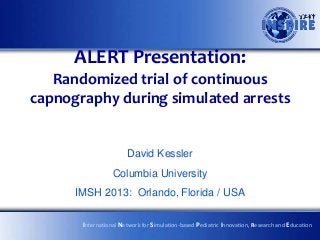
Randomized Trial of Continuous Capnography during Simulated Arrests
- 1. ALERT Presentation: Randomized trial of continuous capnography during simulated arrests David Kessler Columbia University IMSH 2013: Orlando, Florida / USA International Network for Simulation-based Pediatric Innovation, Research and Education
- 2. Background • Continuous capnography recommended during CPR to help guide therapy (2010 PALS guidelines- Class IIa LOE C) • Proven benefits: – rise in petco2 precedes clinical recognition of return of spontaneous circulation (ROSC) – 100% sensitive for ROSC • Theoretical benefits: – Improved compressions – Decreased # of pulse checks and pauses (lower no flow fraction) – Avoiding excessive ventilation – Earlier recognition of futile resuscitations International Network for Simulation-based Pediatric Innovation, Research and Education
- 3. PICO Question • P: In-hospital resuscitation teams • I: A. Use of continuous capnography (CC) B. CC + education • C: Teams with no CC monitoring available • O: Performance on simulator – Vfib arrest – Primary outcomes: time to recognition of ROSC,no-flow-time fraction, compression quality (depth, ETco2 amount, speed) – Secondary outcomes: timing/# of epinephrine & defibs, # pulse checks, RR International Network for Simulation-based Pediatric Innovation, Research and Education
- 4. Approach / Design Outcomes: Outcomes: ETCo2 Time to ROSC Time to ROSC CPR quality CPR quality No flow fraction No flow fraction (RETENTION) ETCo2+education Control Randomization Simulation 1 Simulation 2 Time = 0 Time = 3 months International Network for Simulation-based Pediatric Innovation, Research and Education
- 5. 3 Questions to improve study 1. Should we consider other populations (prehospital setting, residents, etc?). Is focus on team or individual (e.g. leader) 2. What simulator would be best? 3. What/who should be the the focus of the education? 4. What other method of assessment should I use International Network for Simulation-based Pediatric Innovation, Research and Education
- 6. Contact Information Name: David Kessler Institution: Columbia E-mail, Phone: drkessler@gmail.com, 516-769-3777 Other Collaborators: Melissa Langhan International Network for Simulation-based Pediatric Innovation, Research and Education
Editor's Notes
- Melissa Langham, Yale
